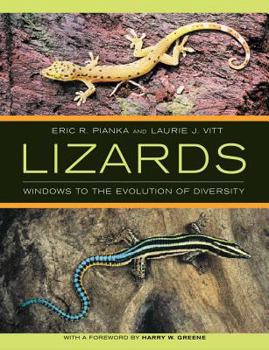Lizards: Windows to the Evolution of Diversity
(Part of the Organisms and Environments Series)
Select Format
Select Condition 
Book Overview
From tiny to gigantic, from drab to remarkably beautiful, from harmless to venomous, lizards are spectacular products of natural selection. This book, lavishly illustrated with color photographs, is... This description may be from another edition of this product.
Format:Hardcover
Language:English
ISBN:0520234014
ISBN13:9780520234017
Release Date:September 2003
Publisher:University of California Press
Length:346 Pages
Weight:3.95 lbs.
Dimensions:1.2" x 8.8" x 11.3"
Customer Reviews
2 ratings
A wonderfully comprehensive overview of an amazing group
Published by Thriftbooks.com User , 19 years ago
Without a doubt, this book is the most comprehensive overview of lizard evolution and ecology, available on the market today. Pianka & Vitt take readers on a tour through the many aspects of the lacertilian suborder. In the process, they show one how incredibly useful lizards have been for science. The book is broken up into three sections. The first section gives an overview of lizards in general. It goes over the basic anatomy, and the distinct differences between the three main lizard groups (Iguania, Gekkota & Autarchoglossa). The second section goes more in depth about each major group. It gives a breakdown of all the major families, and even goes so far as to explain the different genera in each. The final section takes the reader through a brief history of the squamata. It explains their evolution throughout the Mesozoic, and ending with a chapter on relationship of lizards with people. The appendix, at the end, gives a taxonomic summary of all the lizard genera known for each family; along with a total species count. While this is already a bit out of date (sad fate for all published material dealing with taxonomy), it is a nice addition. The chapter on lizards and humans, has a nice section talking about lizards as pets. In the past, herpetologists have often frowned on the keeping of lizards as pets. Pianka & Vitt considered doing the same. Yet, as they mention: "We would be hypocrites if we did." They realize that most up and coming (and many professional) herpetologists/paleontologists, keep/kept lizards as pets. Herpetoculture is here to stay. As such, it makes more sense to learn the most one can about the animal they intend to keep. Reading words of acceptance from those in the field, is always an encouraging thing to see. Of course, not everything about the book is perfect. I did have some minor gripes with it. For starters, I took minor issue with the treatment of the three main lizard groups. In particular, the treatment of Iguanians compared to the scleroglossans. The scleroglossan lizards are often exalted above the iguanians, at the latter's expense. I can understand Pianka & Vitt's reasoning behind this. Scleroglossa make up the majority of living lacertilians, yet remain the least studied group of lizards out there. In that sense, I can't blame the authors for wanting to put more emphasis on this group. I just wish that it didn't appear to be at the expense of the iguanians. It's not done all that often, and it's never intentional, but every once in a while, a comment is made on the archaic nature of iguanians that tends to make them out as sounding inferior. A neat thing about the second part of the book, is that Pianka & Vitt do explain the meaning behind many of the genus names. Unfortunately, they don't do it for all of them. This wouldn't be so troublesome if it didn't happen so randomly. For instance, in the beginning of the agamid descriptions, a definition for each genus name is given. Yet at, roug
Pianka and Vitt's "Lizards" a remarkable contribution
Published by Thriftbooks.com User , 20 years ago
This book is truly amazing! As a scientist, I have read hundreds of works, but never have I encountered a better combination of scientific rigor coupled with what one might call, popular appeal. The authors have basically provided the contribution of record on lizard biology, while simulataneously producing one of the most interesting coffee table "thumb-throughs" that one could imagine. First the biological rigor. Pianka and Vitt break the book into three sections, very appropriately I believe, beginning with lizard behavior--evolution, life history, context. These seven chapters lead naturally to a second section, six chapters devoted to lizard diversity. Not anatomical or taxonomical hell at all, but brilliantly protrayed, ecologically situated depiction of form and function, from iguanas to dragons. The third section ties together the ethology, the diversity of genera, as a well articulated synthesis. In so doing in this concluding synthesis, the authors have managed to write a tutorial that is extremely valuable as a stand alone study plan for teaching evolution and biology to students of just about any level of sophistication. Yes, the book provides comprehensive documentation, references, and taxonomic details--it is a remarkable scientific work. But it is one that can't be put down--the authors even share their personal histories of interest, and they embed numberous "so what? boxes". I found the professional quality photo's to merit review themselves as a contribution to photography. In fact, after walking through the habitat-borne illustrations, I felt that I had spent an eye-opening day with these creatures. "Lizards: Windows to the Evolution of Diversity" is a must for biologists, and a gotta have for anyone interested in creatures. Harry Greene's foreward claim that the book is "a survey of unprecedented depth and breadth" is classic understatement.





